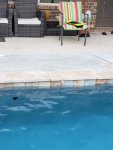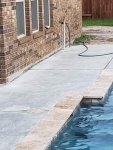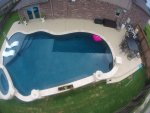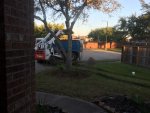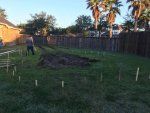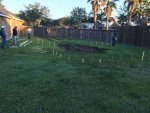Yes, exactly. I'm not assuming you don't know the following, but someone else reading your thread might not: Think of the required plumbing line as the same thing as a drain under your sink. Go have a look. See that u-shaped bit of drain? That's a p-trap. It traps a bit of water in the bottom of the U, and that keeps sewer gases from backing up through the pipe and leaking into your living space. That's why, even though your drain is connected to the sewer, it doesn't stink up your house.
So your city wants the same setup, a similar drain line, starting at your pool pad and connected to your sewer, just as your sink's drain is. The line at your pad is not connected to anything at the pad. It's not connected to your pool in any way. I'm guessing it'll have some sort of cap on it. So if you have a filter that required backwashing, that backwash line would be connected to the p-trap, either permanently or temporarily (I'm not sure how that all works), so that when you back wash the filter, the waste water and all the crud you're cleaning out of the filter will run into the sewer, instead of onto your dirt, or wherever. Just as if you poured it down your sink.
Similarly, the city probably doesn't want you emptying your pool down a hill, or into a creek, or down your street into a storm drain. They want you to empty your pool into the sewer system. So if you had to drain your pool, you'd connect the pump doing the work to a hose and run that hose to the p-trap line, temporarily, and pump the pool water into the sewer, just as if you're pouring it down your sink.
So it's actually a convenience to have it there, and you'll probably use if from time to time, even though you have a cartridge filter.
If the city didn't insist they be installed at the pad, and merely enacted a statute that required everyone to empty their pool into their sewer, it'd likely get ignored, because there's no convenient way to pump a pool into your sewer pipe, and everybody would just empty their pools into the street, which would run down the street to the storm drain and probably pollute some river or lake down stream somewhere. By forcing people to install this sewer line at the pad, the city is hoping more people will likely use it. The p-trap is intended to seal off the pipe from sewer gas, so it doesn't stink up your yard. If you do ever smell it, it's because the water in the p-trap finally evaporated, and you run a hose down it for a few seconds to fill the trap up again.
One more thing to remember: if you don't have a spankin' clean sewer line, maybe it's plugged up with tree roots or something, and you start pumping a pool's worth of water into it, at the kind of volume and pressure a pool pump is capable of, that much water will hit the clog and have nowhere to go. Nowhere, that is, except backwards: right back up your p-trap line, and unfortunately, right back up every other line, too: sinks, tubs, toilets, etc. So if/when you pump water into the thing, be aware of this possibility, and start slow, have someone inside watching the sink/tub/toilet closest to your sewer line, ready to shout if things go wrong.
It'd be prudent to call your water company (or sewer company?) and ask about all this, before you drain your pool into the p-trap. It's possible they only want backwashing to go into the sewer, and a full pool drain to go somewhere else, or pretreated in some way. Each city is different.
That's about all I know on the subject, and some of that I didn't even have to make up!!



